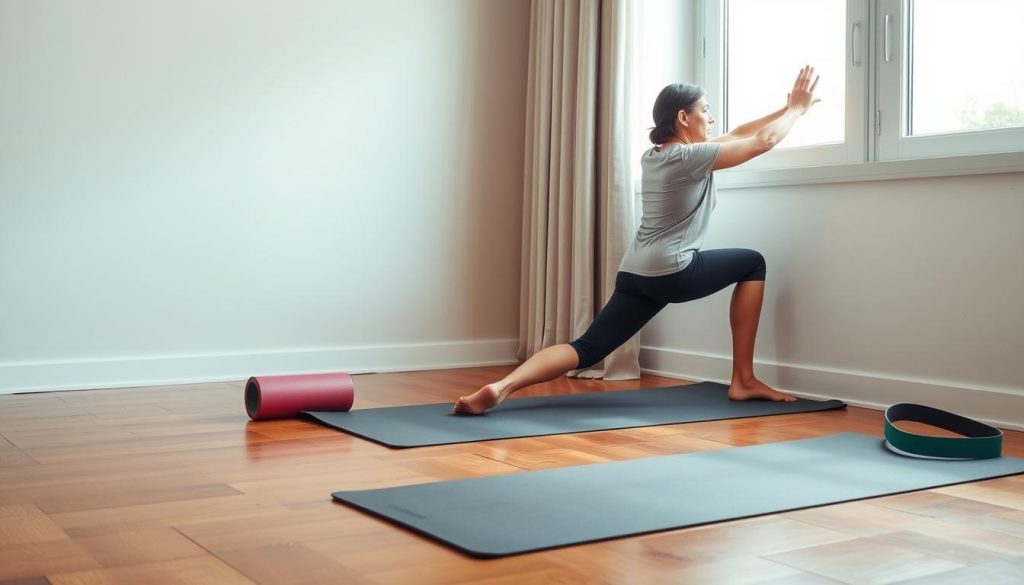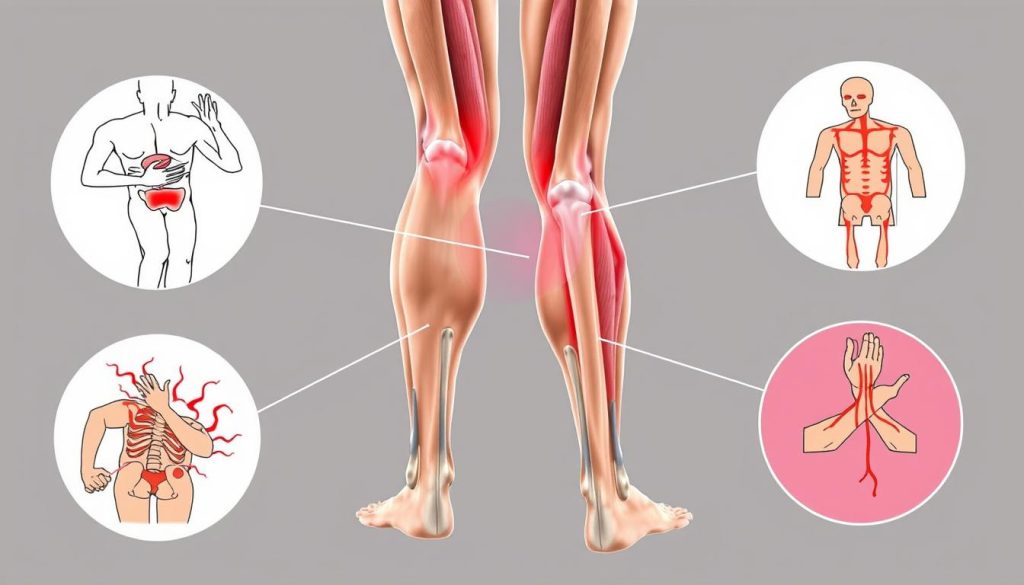Feeling pain in upper calf behind knee can be confusing and tough. It can make everyday tasks harder and lower your quality of life. This pain happens where the knee and calf meet, needing our focus and understanding.
Our article will explore many reasons for calf pain, focusing on behind the knee pain. We’ll look at the causes and the best ways to fix this discomfort.
Knowing what to expect is key, and for those who’ve had surgery, Healthwith.com’s guide on knee replacement is very helpful. As we dive into more, you’ll get medical facts and tips to deal with calf pain and behind knee pain. Let’s explore the way to recovery and better health together.
Understanding the Anatomy of the Knee and Upper Calf
The knee and upper calf are key for moving around. Knowing how they work together is vital for fixing pain issues. We’ll look at what makes up these parts and how they affect each other.
The Knee Joint: A Complex Structure
The knee is very complex. It has the femur, tibia, and patella bones. These bones are held together by ligaments and cushioned by cartilage.
This setup lets us move in many ways, like walking and jumping. But, its complexity also makes it prone to injury. This can hurt both the knee and the calf muscles.
Muscles of the Upper Calf: An Overview
The upper calf has important muscles, like the gastrocnemius and soleus. These muscles help us move and keep stable. They support the foot and lower leg during activities.
Problems with these muscles can cause pain in the calf. This pain can also affect the knee because of their connection.
How Knee and Calf are Interconnected
The knee and upper calf work together closely. Movements in the calf affect the knee. On the other hand, knee issues can strain the calf muscles.
It’s important to understand this connection for proper diagnosis and treatment.
Spotting symptoms of knee and calf pain is the first step to getting help. We’ll look at what to do next in the following sections.
Common Causes of Pain in Upper Calf Behind Knee
Understanding why pain occurs in the upper calf behind the knee is key. This part will look at several reasons for calf pain causes and upper calf strain.
- Physical Overuse: Doing too much that stresses the calf muscles can cause strains and tears.
- Sudden Movements: Quick, intense activities can lead to upper calf strain right away.
- Inadequate Warm-up: Not warming up properly can make muscles more likely to get hurt.
Some medical conditions also cause pain behind the knee:
- Baker’s Cyst: Fluid swelling behind the knee can press on the upper calf muscles, causing pain.
- Deep Vein Thrombosis (DVT): A blood clot in the leg can cause severe calf pain and swelling.
- Peripheral Artery Disease (PAD): Poor blood flow to the legs can lead to calf pain, mainly when exercising.
Knowing these causes is important for preventing and treating pain. The information on calf pain causes helps find the root of the problem. It also guides when to see a doctor.
| Cause Category | Description | Typical Symptoms |
|---|---|---|
| Physical Strain | Overuse or improper use of calf muscles during physical activities. | Muscle tightness, sharp pain, possible swelling. |
| Medical Condition | Underlying health issues such as DVT or PAD. | Consistent pain, swelling, warmth in the affected area. |
| Accidental Injury | Immediate injury due to accidents or missteps. | Sudden severe pain, inability to use the muscle effectively. |
Identifying Symptoms of Upper Calf Pain
Knowing the signs of upper calf pain is key for treating calf pain treatment. The pain can feel like a dull ache or a sharp, intense pain. This often means there’s a problem with the calf muscles. By knowing the difference between general pain and specific symptoms, you can manage your calf muscle pain better and find the right treatment.
Characteristics of Calf Muscle Pain
Calf muscle pain often shows up as sudden, sharp pain during exercise. It can also feel tender when you touch the calf, swell, and feel tight in the leg muscles. These signs can really affect how you move and do daily tasks.
Here are common signs you might have calf muscle pain:
- Sharp pain that gets worse with exercise
- Pulling or snapping feelings in the calf
- Redness or bruising on the calf
- Hard time moving your foot up or down
When Pain Indicates an Upper Calf Strain
Spotting an upper calf strain means looking for specific signs. This usually happens from too much use or misuse, causing muscle damage.
Signs of an upper calf strain include:
- Pain that doesn’t go away even when resting
- Quick swelling after an injury
- A popping sound at injury time
- Weakness in the calf when walking or standing
For more on muscle injuries and symptoms, check out a reliable source. You can find helpful info here.
| Symptom | General Muscle Pain | Upper Calf Strain |
|---|---|---|
| Pain Type | Mild to moderate aching | Sharp, sudden pain |
| Appearance of Symptoms | Gradual onset | Immediate post-injury |
| Impact on Mobility | Moderate | High |
| Pain Occurrence | During or after physical activity | Constant, aggravated by movement |
Exploring Pain Behind Knee: Possible Conditions
When we talk about knee pain, pain behind knee is a big concern. We need to look at different conditions that might cause this pain. This part will cover joint problems and soft tissue injuries to help you understand what might be wrong.
Joint-Related Causes of Knee Pain
Joints in the knee can hurt for many reasons. Baker’s cysts, which are fluid-filled sacs from joint inflammation, are one example. Arthritis and degenerative diseases also affect the knee differently. These issues often cause swelling, stiffness, or sharp pain that gets worse when you move.
Soft Tissue Injuries Resulting in Pain
Soft tissue injuries, like muscle, ligament, and tendon problems, can also cause pain behind knee. Issues like hamstring injuries, calf strains, or tears can lead to sudden pain during exercise. You might also feel tenderness when you touch the area behind your knee.
Knowing what might be causing knee pain is the first step to feeling better. It’s important to see a doctor to get a proper diagnosis and treatment plan.
Diagnosing Calf Pain Causes and Their Connection to the Knee
It’s key to understand the calf pain causes and how they relate to knee problems. Calf pain diagnosis uses different methods to find out where the pain comes from. This helps figure out if the pain is just in the calf or if it affects the knee too.
Doctors start by asking a lot of questions to learn about your symptoms and past injuries. This helps them know if the pain is a one-time thing or if it’s part of a bigger issue with the knee.
- Detailed physical examination to check for tenderness, swelling, and range of motion
- Imaging tests such as X-rays or MRIs to visualize the bone and soft tissue structure
- Ultrasound to assess the soft tissue directly and check for signs of strain or tear
- Blood tests to rule out infection or clotting disorders that could manifest as calf pain
After getting this information, doctors can usually tell what’s causing the calf pain and if it’s related to the knee. They use what they find in the exam and on images to get a full picture of your health. This leads to a correct calf pain diagnosis.
| Diagnostic Tool | Purpose | Connection to Knee Issues |
|---|---|---|
| Physical Exam | Assesses muscle condition, joint function | Identifies knee alignment impacting calf muscle |
| X-ray | Views bone structure | Reveals joint degeneration or misalignments |
| MRI | Provides detailed images of soft tissues | Detects soft tissue damage near the knee |
| Ultrasound | Visualizes muscle and tendon integrity | Evaluates fluid or inflammation near the knee |
| Blood Tests | Checks for systemic issues that could cause pain | Discerns inflammatory markers that could imply joint diseases |
Figuring out what’s causing calf pain and linking it to knee health is key for treatment. This detailed approach helps treat both pain spots together. It speeds up recovery and stops future problems.
Medical Interventions for Calf Pain Treatment
There are many medical interventions for calf pain to help with relief and recovery. These include medicines and physical therapy, each designed for different needs. They help those with calf pain find comfort and get better.
Medications and Pain Relief Options
Doctors suggest various medicines for calf pain. For mild pain, they might recommend acetaminophen. For more pain, NSAIDs like ibuprofen can help. In serious cases, stronger drugs might be needed.
It’s important to take these medicines as told by a doctor. This helps avoid bad side effects and ensures the best treatment.
Physical Therapy for Rehabilitation
Physical therapy is key in treating calf pain. It includes manual therapies, exercises, and sometimes special treatments like ultrasound. Physical therapists aim to improve muscle function and range of motion.
They create exercise plans that help build calf strength safely. This helps patients get back to their daily lives faster.
In summary, treating calf pain well often needs a mix of medicines and physical therapy. Talking to healthcare experts helps get a treatment plan that fits your needs and goals.
Home Remedies and Self-Care for Upper Calf Pain
Dealing with upper calf pain can be tough. But, there are many home remedies that can help. These self-care tips are easy to add to your daily routine.
- Rest: Make sure to rest well after activities that hurt your calf. Resting helps your muscles heal and prevents more damage.
- Ice Therapy: Ice can reduce swelling and ease sharp pain. Use a cold pack for 15-20 minutes every two to three hours when the pain is worst.
- Compression: A compression wrap or sleeve can support your calf and reduce swelling.
- Elevation: Keeping your leg up, above heart level, helps with blood flow and swelling.
For pain, you can try over-the-counter pain relievers like ibuprofen or acetaminophen. But, always follow the instructions to avoid side effects.
| Method | Description | Frequency | Duration |
|---|---|---|---|
| Ice Therapy | Apply ice pack to reduce inflammation. | Every 2-3 hours | 15-20 minutes |
| Compression | Use elastic wraps or sleeves for support. | Throughout the day | As needed |
| Elevation | Prop leg higher than the heart. | During rest | 30 minutes |
These methods can help with mild to moderate calf pain treatment. But, if the pain doesn’t get better or gets worse, see a doctor. They can check for more serious issues.
Exercises Tailored for Calf Muscle Pain Relief
Targeted exercises can greatly help with calf pain recovery and injury prevention. This section will cover specific exercises for calf muscle pain relief. We’ll focus on stretching and strengthening routines.
Stretching: The First Line of Therapy
Stretching is key for relieving tight calf muscles and boosting flexibility. Regular stretching helps with pain relief and lowers injury risk. Here are some essential stretches to add to your routine:
- Standing Calf Stretch: Ideal for elongating the calf muscles gently.
- Seated Calf Stretch: Perfect for focusing on deeper stretch with controlled movement.
- Downward Dog Pose: A yoga pose that helps in stretching both calves simultaneously.

Strengthening Exercises for Resilience
Strengthening the calf muscles is vital for stability and endurance. These exercises reinforce muscles and tendons, easing the load on the calf during activities. Key exercises include:
- Calf Raises: Simple yet effective movement to enhance muscular strength.
- Leg Press: Focused resistance training helps increase calf strength and endurance.
- Box Jumps: Boosts power and resilience in the calves.
Adding these exercises to your fitness routine can significantly improve calf muscle performance and pain relief.
| Exercise | Type | Benefits |
|---|---|---|
| Standing Calf Stretch | Stretching | Increases flexibility, reduces stiffness |
| Calf Raises | Strengthening | Builds muscle, enhances stability |
| Downward Dog Pose | Stretching | Stretches both calves, improves alignment |
| Leg Press | Strengthening | Increases strength and endurance |
| Box Jumps | Strengthening | Improves muscle power and resilience |
Understanding Chronic vs. Acute Calf Pain
Distinguishing between chronic calf pain and acute upper calf pain is key for effective treatment. Both types of pain can affect daily life, but knowing the difference helps choose the right treatment.
Chronic calf pain develops slowly and lasts for weeks or months. It feels like a dull ache that gets worse with activity or standing. In contrast, acute upper calf pain comes on suddenly, often from injury. It’s sharp and severe, needing quick attention to avoid more harm.
| Feature | Chronic Calf Pain | Acute Upper Calf Pain |
|---|---|---|
| Onset | Gradual | Sudden |
| Nature of Pain | Dull, persistent ache | Sharp, intense pain |
| Duration | Long-term (weeks to months) | Short-term (days to weeks) |
| Common Causes | Overuse, aging, underlying medical conditions | Injury, sudden physical impact |
| Treatment Approach | Long-term management, lifestyle adjustments | Immediate care, possibly emergency treatment |
Knowing the difference between chronic calf pain and acute upper calf pain helps in choosing the right treatment. It also sets realistic recovery goals and timelines. Each type of pain has its own challenges, requiring a personalized approach for the best results.
Prevention Tips: Avoiding Pain in Upper Calf Behind Knee
Dealing with pain in your upper calf, behind the knee, can be tough. But, the right steps can help a lot. Focus on good posture and warm-ups and cool-downs to avoid pain.
Maintaining Proper Posture and Alignment
Keeping the right posture is key to avoiding pain in your upper calf and behind the knee. Standing and moving correctly spreads out your weight. This reduces stress on your leg, lowering the chance of muscle or ligament issues.
Importance of Warm-Ups and Cool-Downs
Starting with a good warm-up gets your muscles ready for exercise. Cool-downs help your body slowly return to rest. Both are essential for avoiding pain in the upper calf behind the knee.
Warm-ups boost blood flow and make muscles more flexible. This lowers injury risk. Cool-downs remove waste that can cause stiffness and soreness.
Here’s a simple routine for warm-ups and cool-downs:
- Begin with 5 minutes of light cardio, like walking, to warm up.
- Do dynamic stretches like leg swings or walking lunges.
- Slow down after exercise instead of stopping suddenly.
- End with static stretches for your calf muscles, holding each for 30 seconds.

Following these steps not only helps prevent pain but also boosts your physical performance.
Professional Treatment Options: From Physical Therapy to Surgery
For those with persistent calf pain, treatment options range from non-invasive physical therapy to surgery. Each method targets different aspects of calf pain. They offer relief and long-term benefits based on the cause and severity of the condition.
Minimally Invasive Procedures for Knee and Calf Pain
Minimally invasive procedures have changed how doctors treat knee and calf pain. Techniques like guided injections, laser treatments, and arthroscopic surgery are used. These methods aim to precisely target problem areas, reducing body impact and speeding up recovery.
When Surgery Becomes a Necessary Option
When physical therapy and other treatments fail, surgery might be considered. Surgery, like calf pain surgery, aims to fix structural issues causing pain. Choosing surgery involves discussing risks and benefits with your healthcare provider.
| Treatment Type | Recommended for | Recovery Time | Effectiveness |
|---|---|---|---|
| Physical Therapy | Mild to Moderate Calf Pain | 4-6 weeks | High |
| Minimally Invasive Procedures | Moderate to Severe Calf Pain | 1-3 weeks | Variable |
| Calf Pain Surgery | Severe Calf Pain or Structural Issues | 6-12 weeks | High |
Impact of Footwear on Calf and Knee Pain
The right shoes can really help if you have calf and knee pain. It’s important to know how your shoes affect your body. This is true for finding the best shoes for calf pain and orthotics for knee pain.
Choosing the Right Shoes for Support
Finding the right shoes is key to easing calf and knee pain. Look for shoes with good arch support and cushioning. They can help reduce stress on your calves and knees, making you feel better.
Make sure to pick shoes that fit your activity level and foot shape. This way, you get the most benefit from them.
Orthotics and Insoles: Do They Help?
Orthotics are special insoles that help correct foot alignment. They can also help with knee pain, which can affect your calves. They distribute pressure better, helping your foot, ankle, and leg.
Whether you’re an athlete or just dealing with daily pain, orthotics can offer a lot of relief. Adding them to your routine might make a big difference.
Here’s a table showing shoe features that can help with calf and knee pain:
| Feature | Benefits | Recommendation for |
|---|---|---|
| Arch Support | Reduces stress on calves and knees | Individuals with flat feet or high arches |
| Cushioning | Absorbs impact, lessens pressure on joints | Regular joggers or people with heavy daily foot usage |
| Heel Stability | Maintains correct leg alignment | Those with ankle instability or prone to sprains |
| Breathable Material | Prevents overheating, reduces blister risk | Users in warm climates or with sweaty feet |
Lifestyle Modifications to Combat Upper Calf Strain
Making lifestyle changes can help manage upper calf strain. Eating right and staying hydrated are key. They boost muscle health and help prevent injuries. Let’s look at how diet and hydration impact muscle performance and recovery.
Dietary Changes for Muscle Health
Eating foods high in proteins, vitamins, and minerals is vital for muscle repair. Proteins, found in lean meats, legumes, and dairy, help muscles heal and grow. Minerals like magnesium and potassium are also important for muscle function and preventing cramps.
Importance of Hydration and Nutrients
Drinking enough water is essential for muscle health. It helps nutrients reach muscle cells and waste leave quickly. This prevents muscle soreness and fatigue. Also, nutrients like Vitamin D and Calcium are important for bone health, which supports the calf muscles and joints.
| Nutrient | Benefits | Sources |
|---|---|---|
| Protein | Supports muscle repair and growth | Chicken, tofu, yogurt |
| Potassium | Aids in muscle function and prevents cramping | Bananas, spinach, avocados |
| Magnesium | Important for muscle relaxation and recovery | Nuts, whole grains, beans |
| Vitamin D and Calcium | Essential for bone strength and function | Milk, fortified cereals, fatty fish |
The Role of Massage and Alternative Therapies in Treating Pain
Many people are now using massage for calf pain and alternative therapies for behind knee pain. These methods help relieve pain and improve body function. They also help heal without needing lots of medicine.
Types of Massage Techniques for Calf Relief
Massage therapy is great for calf pain. Techniques like Swedish massage, deep tissue massage, and trigger point therapy work well. They reduce tension, improve blood flow, and help the body heal faster.
Exploring Acupuncture and Acupressure
Acupuncture and acupressure are key in alternative therapies for behind knee pain. They come from traditional Chinese medicine. By stimulating certain body points, they help lessen pain and swelling. This makes them a good choice for long-term knee and calf pain.
When to Seek Immediate Medical Attention for Calf Pain
In some cases, calf pain is a sign of a serious health issue that needs medical attention for calf pain right away. It’s important to know when to act fast to avoid bigger problems.
There are certain signs that mean you should see a doctor quickly. Here are the key ones:
- Severe calf pain that comes on suddenly and has no obvious reason
- A calf that looks swollen, warm, and red
- Having trouble putting weight on or walking on the affected leg
- Open wounds or signs of infection like pus
- Pain that also makes your chest hurt or makes it hard to breathe
These signs might mean you have serious problems like deep vein thrombosis (DVT), muscle tears, or infections. All of these need quick medical attention for calf pain.
| Condition | Symptoms | Action |
|---|---|---|
| Deep Vein Thrombosis (DVT) | Swelling, pain, redness, warm to touch | Urgently visit a healthcare provider |
| Compartment Syndrome | Severe swelling, exacerbated pain, numbness | Seek immediate emergency care |
| Cellulitis | Increasing redness, warm on touch, fever | Immediate medical treatment required |
| Muscle Tear | Sharp, sudden calf pain, bruising | Consult a doctor promptly |
In short, waiting too long to get medical attention for calf pain when you see these signs can lead to serious issues. It’s safer to be cautious and see a doctor right away.
Navigating Healthcare: Working with Your Doctor for Pain Management
When dealing with pain in the upper calf behind the knee, working closely with your doctor is key. Good pain management needs the right diagnosis and a plan made just for you. A doctor for calf pain who knows your story can help create a treatment plan that fits you.
Start by telling your doctor when your pain started, how long it lasts, and how bad it is. Giving them all the details helps them find the right treatment for you.
Building a good relationship with your doctor means they listen to you and help you. When planning your pain management, learn about your pain and why you’re getting certain treatments. This includes medicines, physical therapy, or changes in your lifestyle. Each step should be clear and something you agree on.
Being involved in your treatment plan makes it more effective. It also lets you make choices about your health. This way, you’re not just following orders, but actively working towards feeling better.
If your pain doesn’t get better or gets worse, talk to your doctor again. They might need to change your treatment or send you to a specialist. Keep going to your doctor and talking openly about your pain. This way, you can manage your pain better and live a better life.
Working with a doctor for calf pain can really help. They can help you find ways to move without pain. This is all about finding relief and feeling better, with your doctor’s help.
FAQ
Q: What causes pain in the upper calf behind the knee?
A: Pain in the upper calf can come from muscle strains, injuries, or joint problems. It’s key to understand the pain’s details and talk to a doctor for a proper diagnosis.
Q: How are the knee and calf interconnected?
A: The knee and calf muscles work together for movement. Issues in one can affect the other due to their connection.
Q: What are the common symptoms of an upper calf strain?
A: An upper calf strain might cause sharp pain, swelling, and bruising. It can also make walking or standing hard. If you see these signs, rest and get medical help.
Q: Which conditions are associated with pain behind the knee?
A: Pain behind the knee can be from Baker’s cyst, hamstring injuries, or arthritis. A doctor’s check-up is needed to find the exact cause.
Q: How is calf pain diagnosed in relation to knee issues?
A: Doctors use a physical exam, review your medical history, and might do imaging tests. This helps find the cause of calf pain and its link to knee problems.
Q: What medical interventions are available for treating calf pain?
A: Treatment depends on the cause. It might include pain meds, injections, physical therapy, or surgery in severe cases.
Q: Can upper calf pain be treated at home?
A: For minor pain, the R.I.C.E method can help. This means rest, ice, compression, and elevation. Over-the-counter pain relievers can also help. But, see a doctor if the pain doesn’t go away.
Q: What exercises can help relieve calf muscle pain?
A: Stretching and strengthening exercises can help. It’s best to get a plan from a physical therapist or fitness expert.
Q: How can chronic calf pain be distinguished from acute calf pain?
A: Chronic pain lasts a long time and often comes from long-standing issues. Acute pain is sudden and intense, usually after an injury.
Q: What are some effective prevention tips for avoiding upper calf pain?
A: Good posture, a proper warm-up, and cool-down exercises can prevent upper calf pain.
Q: What professional treatment options exist for calf and knee pain?
A: Treatments range from physical therapy and medication to minimally invasive procedures or surgery if needed.
Q: How does footwear influence calf and knee pain?
A: The right shoes can reduce stress on the calf and knee. Orthotics can also help if foot issues contribute to pain.
Q: What lifestyle changes can help manage upper calf strain?
A: Eating right, staying hydrated, and getting the right nutrients are key for muscle health. They can help manage and prevent upper calf strains.
Q: Can massage and alternative therapies treat pain in the calf and behind the knee?
A: Yes, massage, acupuncture, and acupressure can help with muscle pain and tension. But, results can vary.
Q: When should I seek immediate medical attention for calf pain?
A: Seek immediate help for severe pain, signs of infection, or suspected blood clots. Sudden swelling or trouble walking are urgent signs too.
Q: How should I work with my doctor for effective pain management?
A: Keep a pain journal, share how pain affects you, and follow treatment plans. Good communication with your doctor is key for managing pain.


















